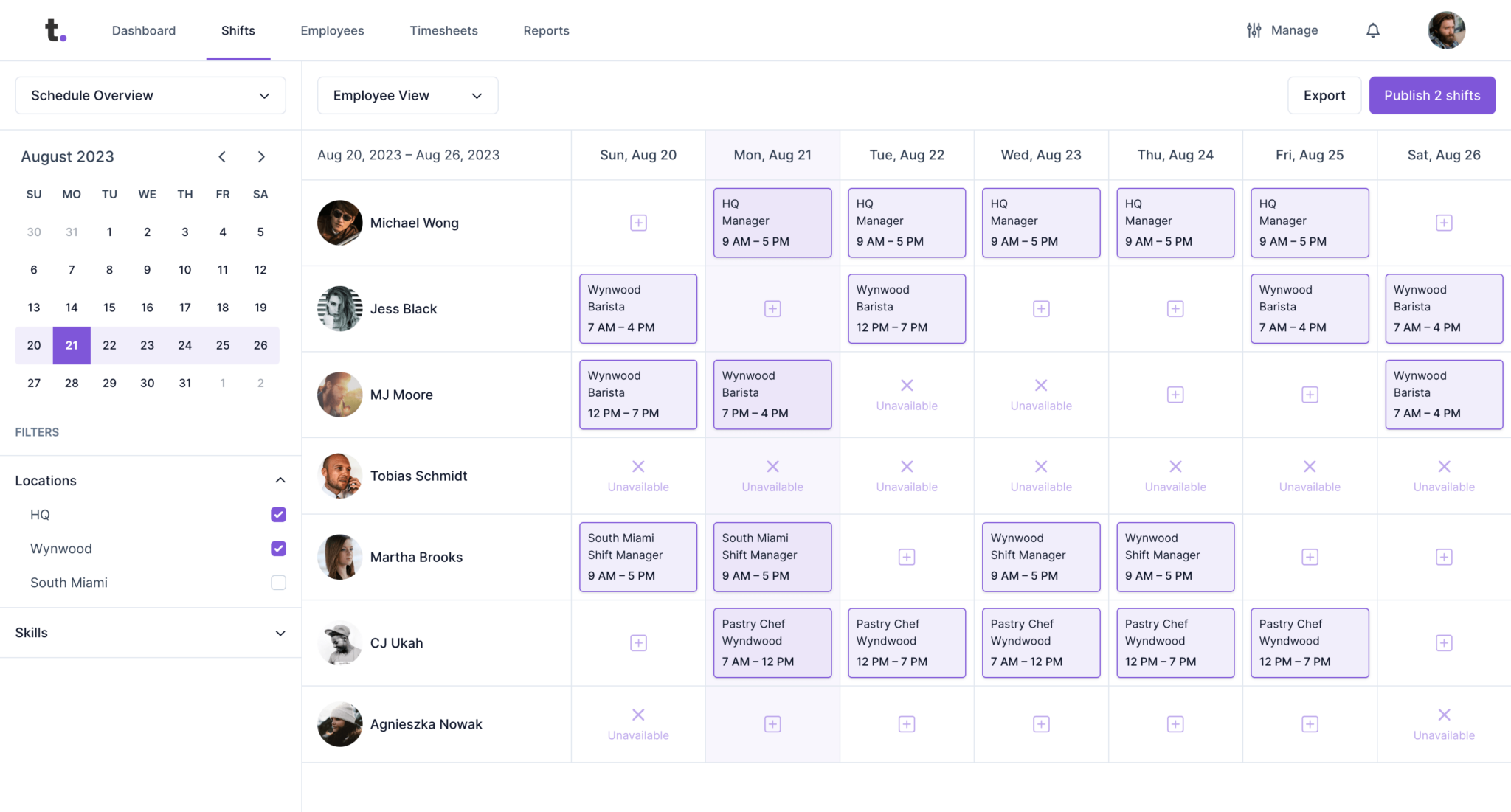How Much Are Scheduling Mistakes Costing Your Business? Hidden Costs & Compliance Risks
When businesses think about labor costs, they often focus on payroll—how much they’re paying employees per hour, per shift, or per week. But the true cost of labor goes beyond just wages. Poor scheduling decisions can silently drain thousands of dollars from a company’s bottom line through unnecessary overtime, inefficient shift planning, compliance penalties, and wasted administrative hours. A single missed meal break or incorrect overtime calculation could result in expensive fines or even wage theft lawsuits. Meanwhile, managers spend hours manually adjusting schedules, responding to last-minute shift changes, and fixing payroll discrepancies—time that could be spent on strategic operations instead.
Every shift change, late clock-in, or unexpected no-show does more than create temporary chaos—it directly impacts labor costs and operational efficiency. No-shows force managers to scramble for replacements, often leading to expensive overtime pay or short-staffed shifts that affect customer service and productivity. Similarly, frequent last-minute schedule changes create confusion, increasing employee dissatisfaction and turnover. On top of that, mismanaged overtime can lead to payroll inflation, where employees rack up unplanned extra hours simply due to poor scheduling visibility. Without smart workforce management tools, these small errors compound into major financial losses every month.

The 5 Biggest Scheduling Mistakes That Hurt Your Bottom Line
Inefficient scheduling doesn’t just cause minor inconveniences—it directly impacts labor costs, employee morale, and overall business performance. From last-minute shift changes to unnecessary overtime, these common mistakes add up quickly, leading to compliance risks and financial losses. Here are the five biggest scheduling mistakes businesses make and how to avoid them.
1. Last-Minute Shift Changes
Last-minute shift changes create chaos for both managers and employees. When schedules constantly shift, businesses often end up paying overtime or premium wages to cover unexpected gaps. This leads to higher labor costs and disrupts operational efficiency. A study from the Washington Center for Equitable Growth found that unpredictable scheduling increases payroll expenses and reduces overall business stability.
Beyond financial costs, unstable schedules impact employee well-being and retention. Research also shows that irregular shifts increase stress and work-life conflicts, leading to higher turnover rates and lower productivity.
To minimize these issues, businesses should use scheduling tools that provide stability while allowing for controlled flexibility. Advanced shift planning software helps anticipate staffing needs, reducing reliance on last-minute changes and keeping both labor costs and employee morale in check.
2. Over-Scheduling & Labor Budget Waste
Over-scheduling occurs when businesses assign more staff than necessary for a given shift, leading to increased labor costs without corresponding benefits. This practice can result in:
Paying wages for idle employees during slow periods.
Decreased employee morale due to perceived underutilization.
Reduced profitability from inflated labor expenses.
Potential complacency among overstaffed employees.
A study conducted by researchers at the University of Oregon found that adopting responsible scheduling practices led to a 1.8% reduction in labor hours and a 5.1% increase in productivity. This indicates that overstaffing not only elevates costs but also diminishes overall efficiency.
Implementing advanced scheduling tools like Timewave can help businesses optimize staffing levels by analyzing historical data and forecasting demand. This ensures that the right number of employees are scheduled for each shift, reducing unnecessary labor costs and enhancing operational efficiency.
3. Under-Scheduling & Lost Productivity
Under-scheduling, or having fewer staff than necessary, can lead to significant productivity losses. Employees may become overburdened, resulting in slower service, increased errors, and diminished customer satisfaction. This strain can also elevate stress levels, contributing to burnout and higher turnover rates.
A report by McKinley Marketing Partners highlights that understaffing often leads to "quiet quitting," where employees disengage due to excessive workloads, resulting in reduced productivity and profitability.
Under-scheduling can be prevented by analyzing historical data, monitoring peak hours, and implementing better shift planning practices. Businesses that proactively adjust staffing based on demand can maintain productivity, reduce employee burnout, and improve overall workplace efficiency. Investing in smarter scheduling strategies ensures that teams remain balanced, reducing the risk of costly inefficiencies.
4. Payroll Errors & Compliance Fines
Inaccurate payroll processing can lead to significant financial penalties, especially in states like California with stringent labor laws. Common errors include miscalculating overtime, failing to provide accurate wage statements, and neglecting mandatory meal and rest breaks. These mistakes not only result in fines but can also damage a company's reputation and employee trust.
California law mandates that employers provide detailed wage statements, including information such as gross and net wages earned, total hours worked, and applicable hourly rates. Failure to comply can result in statutory penalties of up to $4,000 per employee. However, the California Supreme Court has ruled that employers with a reasonable, good faith belief that they are compliant may avoid these penalties.
To navigate these complexities, businesses can utilize specialized workforce management tools designed to ensure compliance with California's labor regulations. For instance, Timewave offers features that help employers adhere to state-specific requirements, reducing the risk of payroll errors and associated fines. Additionally, we provide free resources like the California Overtime Wage Calculator and the California Meal Break Calculator to assist businesses in accurately calculating employee compensation and maintaining compliance.
5. Manual Scheduling Takes Too Much Time
Manual employee scheduling is a time-consuming process that often leads to inefficiencies. Managers can spend up to 20% of their working hours creating and managing schedules, diverting attention from strategic tasks.
This manual approach is not only labor-intensive but also prone to errors, which can result in increased employee turnover and decreased productivity. Implementing automated scheduling solutions can significantly reduce the time spent on these tasks, allowing managers to focus on more critical aspects of operations.
By adopting such tools, businesses can improve efficiency, reduce labor costs, and enhance overall workforce satisfaction.

How to Fix Scheduling Problems & Cut Costs in 2025
Let’s be real—scheduling headaches cost you time, money, and unnecessary stress. But it doesn’t have to be that way. Web-based scheduling tools help you stay ahead of last-minute changes by predicting staffing needs, preventing shift conflicts, and ensuring you’re never scrambling to fill a shift again.
You also need to keep labor costs under control. With real-time tracking, you can see exactly where you're overspending, avoid unnecessary overtime, and make sure you're staffing just the right amount—no more, no less. That means fewer surprises when payroll hits.
And if you’re in California, compliance is a whole other battle. Timewave takes that off your plate by automatically tracking meal breaks, overtime, and wage laws so you’re never at risk of expensive violations or lawsuits.
It’s time to stop guessing and start optimizing. Try Timewave for free today and see how much easier scheduling (and running your business) can be.